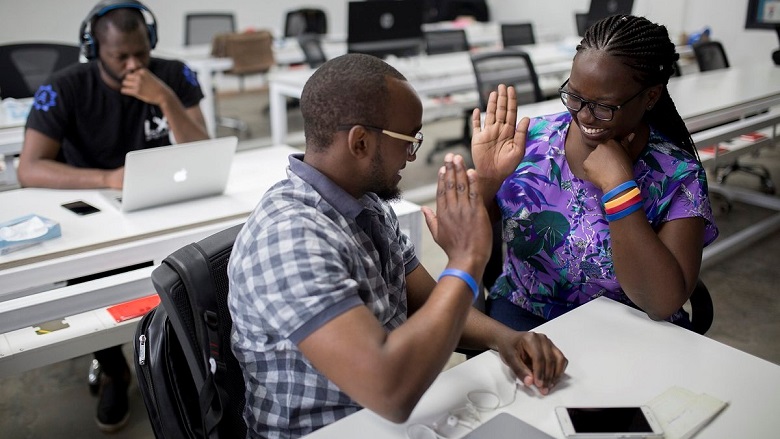In recent years, Africa has made remarkable progress in digital literacy and infrastructure—the rollout of mobile broadband and the expansion of mobile money ecosystems have connected millions more than ever before. Yet, despite these gains, online banking adoption remains stubbornly low. A growing body of research reveals that the principal barrier isn’t hardware, network coverage, or even affordability—it’s poor digital literacy. This invisible yet formidable challenge prevents millions of Africans from fully embracing the convenience and empowerment that online banking promises.
Table of Contents

Digital Literacy: The Forgotten Digital Divide
When we talk about digital barriers across Africa, the usual suspects come to mind—weak infrastructure, high costs, low mobile penetration, and lack of awareness. However, recent data shows that even individuals with smartphones struggle to engage online because they simply don’t know how to navigate the digital landscape.
GSMA reports a stark reality: in Sub-Saharan Africa alone, many people own internet-capable devices yet never go online—“they have the money to buy it, but just don’t know what to do with it,” as Angela Wamola of GSMA says. This lack of familiarity with digital tools is decimating the potential of online banking.
In Nigeria, for instance, only 45% of women are aware of mobile internet, compared with 62% of men—meaning more than half of women are effectively cut off from basic access opportunities, according to Wikipedia. And literacy is a core issue: among women without mobile phones in Nigeria, 40% cite illiteracy as a barrier, while only 22% of men do.
Such gaps reflect not just connectivity issues, but a deeper socio-technical chasm—knowing how to use digital services matters as much as owning them. Without clear guidance, intuitive interfaces, and trust in digital systems, even the most promising financial platforms remain out of reach.
Gender and Rural Disparities: Digital Literacy’s Unequal Toll
These literacy hurdles are not evenly distributed. Women and rural populations are disproportionately affected.
According to GSMA, women in LMICs (low- and middle-income countries) are 19% less likely to use mobile internet than men. In Sub-Saharan Africa, the gender gap is even more stark—with some estimates showing that for every three men online, only two women have similar access.
On the rural front, access to connectivity remains low, but beyond that, the capacity to use digital tools effectively is weaker still. Even where mobile broadband exists, digital literacy remains low—creating a “usage gap” as GSMA calls it, where infrastructure is present but usage is minimal.
In Nigeria’s rural areas, digital literacy hurdles are compounded by low general literacy: urban female literacy stands at about 59%, while in rural areas it’s just 34%. This gulf is doubly discouraging: without basic reading skills and confidence in using digital devices, women in rural areas are practically excluded from online banking.

Digital Literacy, Trust, and the Take-Up of Online Banking
Beyond awareness and basic skills, trust and perceived risk shape adoption decisions. Cybersecurity concerns are rising across Africa, and they amplify the fear that keeps users offline.
Research from KnowBe4 shows increasing worries about cybercrime—African users are more anxious now than two years ago about online threats, including deepfakes, fraud, and ransomware. If users lack confidence in their ability to recognise scams or feel unsupported when things go wrong, they’re less likely to try online banking at all.
Moreover, urban-focused campaigns often overlook the real learning environments people need. Studies in southeast and south-south Nigeria found that although awareness of digital banking reached 36% during cash shortages, actual acceptance and usage improved only slightly (37%), heavily influenced by communication efforts. This shows that messaging alone—without sustained digital literacy support—is not enough.
Solutions Rooted in Digital Confidence
All is not lost. While digital literacy emerges as the top barrier, its human-centred nature means it can be addressed with targeted, compassionate policies.
- Integrate digital literacy training with banking services.
Financial institutions and fintechs should embed simple, localised tutorials—offered via voice guides, video, or in-person training—into their platforms. GSMA’s collaboration with Visa to craft financial literacy content for women, micro-merchants, refugees, and smallholder farmers is a promising example - Leverage trusted community intermediaries.
Tech Herfrica, based right here in Abuja and active across six African countries, empowers rural women and girls with digital and financial literacy training and support. Such organisations tailor solutions to cultural and educational realities—closing trust gaps and fostering confidence. - Localise content and language to build comfort.
A lack of relevant, local content—especially in indigenous languages—dulls the appeal of digital services. Platforms should prioritise vernacular content and intuitive interfaces to foster familiarity and encourage exploration. - Collaborate with local governments and NGOs.
Public-private partnerships can deliver digital confidence programmes through schools, community centres, and rural hubs—especially in areas unreachable by conventional infrastructure. This also aligns with broader goals to bridge digital divides. - Offer ongoing support and feedback channels.
Even after training, users need reassurance. Support via chat, phone, or community help desks can reinforce learning and build trust. Financial inclusion isn’t a one-time campaign—it’s a continuous, human journey.

Why This Matters
As someone who grew up watching cashiers across Lagos worship at ATM buttons—hesitating, confused, or sometimes giving up altogether—I’ve seen firsthand how digital literacy shapes our economic lives. Online banking isn’t just a convenience; it’s a doorway to independence and inclusion. It means paying school fees without queues, saving securely, transferring money across states, or receiving payments for side hustles—all within a few taps.
But when someone isn’t sure what the “menu” or “settings” icon does, or fears they’ll accidentally send money to the wrong number, that door remains bolted.
Building digital confidence—especially for our women, rural folks, and older adults—is not optional. It’s the linchpin for a digitally inclusive Africa.
Conclusion
So, while policymakers and tech leaders are rightly fixated on expanding connectivity, lowering data costs, and scaling infrastructure, we must not neglect the human side of digital transformation. Digital literacy is not a minor footnote—it’s the main headline. As the top obstacle to online banking adoption across Africa, it demands empathy, local-rooted strategies, and sustained investment.
By making digital tools accessible, relevant, and safe—regardless of location or education—we open not just bank accounts, but new opportunities, confidence, and hope.
Join Our Social Media Channels:
WhatsApp: NaijaEyes
Facebook: NaijaEyes
Twitter: NaijaEyes
Instagram: NaijaEyes
TikTok: NaijaEyes















![Trailblazing Chef Hilda Baci Set to Cook 250 Bags of Rice in Daring Attempt to Break Record for World’s Biggest Jollof Pot [VIDEO] Hilda Baci](https://naijaeyesblog.com/wp-content/uploads/2025/09/hilda-1-180x135.avif)
























